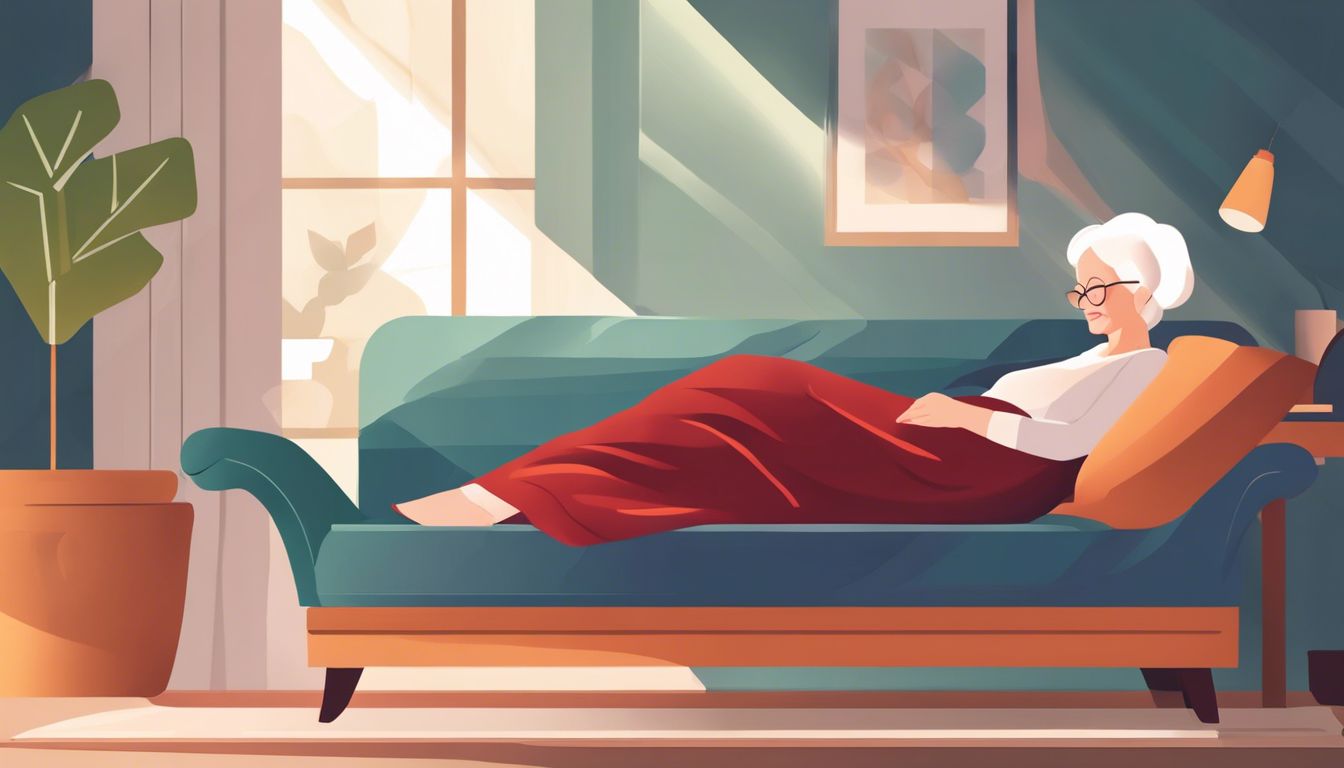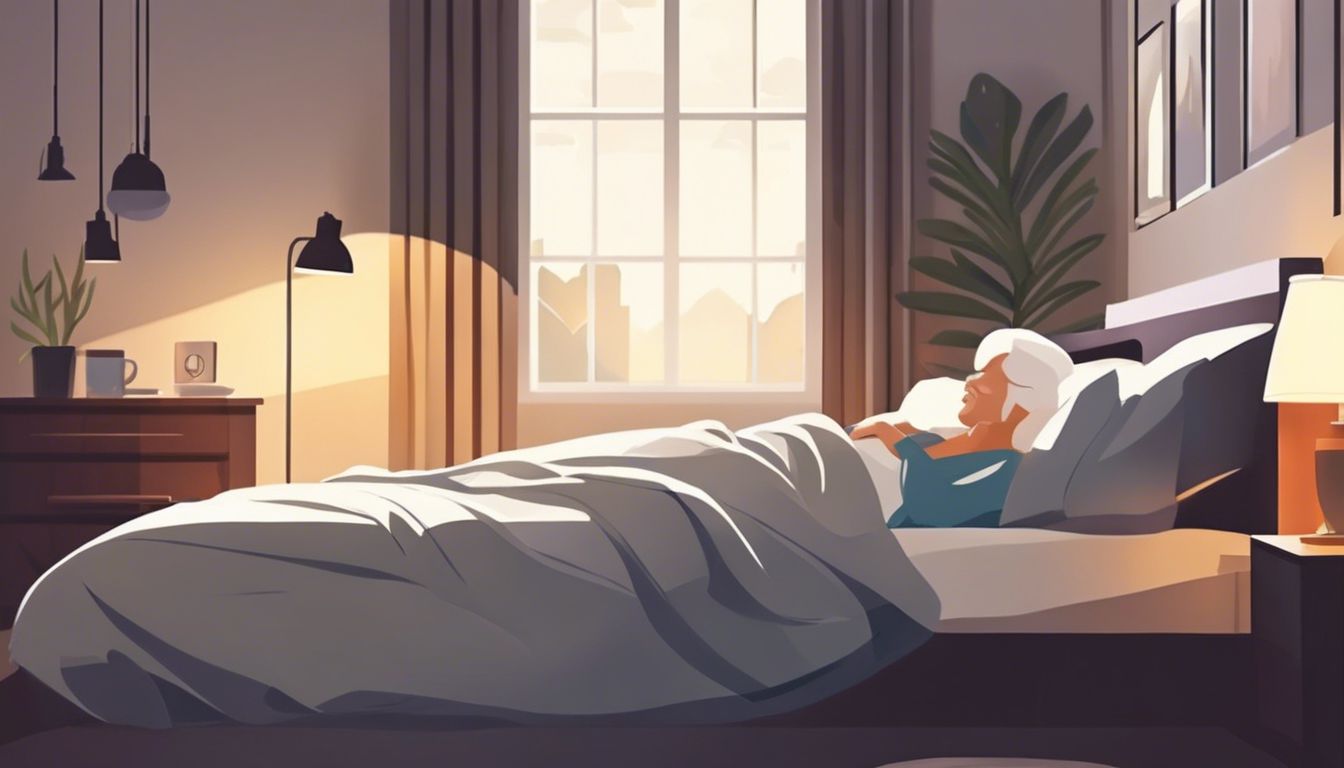Are you caring for an older adult who often feels tired during the day? Napping can be a powerful tool for seniors to boost energy and improve well-being. Research shows that short daytime naps can enhance memory and cognitive function in older adults.
This article will explore the benefits of napping for seniors and provide practical tips for incorporating naps into daily routines. Ready to learn more?
📋✅
- Short 20-30 minute naps boost memory, mood, and alertness in seniors without disrupting nighttime sleep.
- Napping between 1-4 PM aligns with natural energy dips and offers the most cognitive benefits for older adults.
- Studies show 30-90 minute naps improve heart health and preserve brain function in elderly populations.
- Over half of older adults in China regularly take afternoon naps, highlighting cultural acceptance of the practice.
- Excessive napping over 90 minutes may increase risks of cognitive decline, diabetes, and heart issues in seniors.
Why Napping is Beneficial for Seniors

Napping offers seniors a natural way to recharge and improve their daily lives. A short rest during the day can sharpen thinking, lift spirits, and increase energy levels for older adults.
Enhances cognitive function
Naps pack a powerful punch for seniors’ brain health. Research shows that older adults who take short afternoon siestas have better memory and thinking skills. A study in China found 65+ year-olds napping 30-90 minutes performed better on word recall and drawing tasks.
These brief rest periods sharpen attention and boost mental clarity.
A short nap can be a secret weapon for seniors’ cognitive function.
Caution is key, though. Longer naps may backfire, causing grogginess and nighttime sleep issues. The sweet spot seems to be a brief midday snooze. This rest break recharges the mind without disrupting normal sleep patterns.
Next, we’ll explore how napping lifts mood and emotional well-being in older adults.
Boosts mood and emotional well-being
Napping offers significant emotional benefits for seniors. Research shows that short daytime naps can improve mood and reduce feelings of anxiety or irritability. This mood-boosting effect is particularly important for older adults who may face challenges like social isolation or health issues.
A brief 20-30 minute nap after lunch often leaves seniors feeling refreshed, more positive, and better equipped to engage with others.
Beyond immediate mood improvements, regular napping may help seniors manage stress levels over time. Lower stress contributes to better overall emotional well-being and can even support cognitive function.
For caregivers, encouraging appropriate nap habits in elderly loved ones could be a simple yet effective way to enhance their quality of life and emotional resilience.
Reduces fatigue and increases alertness
Building on the mood-enhancing effects, napping also combats fatigue and sharpens alertness in seniors. A brief rest during the day can recharge energy levels, helping older adults feel more refreshed and focused.
This boost in alertness is particularly beneficial for maintaining cognitive function and improving reaction times.
Research shows that a 20-minute power nap can significantly reduce drowsiness and increase mental acuity. For seniors struggling with daytime sleepiness, a short nap between 1-3 PM can help reset their internal clock and provide a much-needed energy boost.
However, it’s crucial to limit nap duration to avoid interfering with nighttime sleep patterns.
Optimal Napping Practices
Napping can refresh and recharge seniors when done right. A good nap lasts 10-30 minutes in the early afternoon, ideally in a quiet, dark room.
Best times for napping
Timing matters for effective naps. Research shows the optimal window for a rejuvenating snooze falls between 1 p.m. and 4 p.m. This aligns with the natural midday dip in alertness many people experience.
For seniors, a post-lunch nap can be particularly beneficial for brain health. Studies indicate that over half of older adults in China regularly enjoy an afternoon siesta, highlighting its cultural significance and potential health benefits.
Nap duration also plays a crucial role in reaping the rewards of daytime rest. While short naps can boost alertness and cognitive function, longer naps might lead to adverse health outcomes.
The ideal nap length varies by individual, but generally, 20-30 minutes suffices for most seniors. Next, let’s explore how to create an environment conducive to restful napping.
Ideal duration for cognitive and health benefits
Research shows that naps lasting 30 to 90 minutes offer the best cognitive and health benefits for seniors. A 30-minute snooze can improve alertness and mood, while a full 90-minute rest allows for a complete sleep cycle, enhancing memory and creativity.
However, longer naps may lead to grogginess and interfere with nighttime sleep patterns. For those seeking a quick energy boost, a 20-minute power nap can provide immediate improvements in performance without causing sleep inertia.
Experts caution against naps exceeding 90 minutes, as they might negatively impact cardiovascular health and diabetes management in older adults. Studies have found that intermediate-length afternoon naps may help preserve cognitive function in elderly populations, particularly in Chinese communities where midday rest is culturally accepted.
Caregivers should encourage seniors to find their ideal nap duration within this 30-90 minute window for optimal benefits.
Creating a conducive napping environment
A peaceful napping space boosts sleep quality for seniors. Dim lighting and comfortable temperatures (around 65°F) promote relaxation. Soft bedding and supportive pillows ease body aches.
Noise-canceling devices or white noise machines mask disruptive sounds.
Air purifiers improve breathing and reduce allergens. Blackout curtains block light, helping maintain a regular sleep cycle. A clutter-free room reduces stress and enhances calm. These elements create an ideal setting for restorative daytime rest, improving cognitive function and mood in older adults.
Health Outcomes Associated with Napping in Older Adults
Napping in older adults can improve heart health and help manage blood sugar levels. Read on to learn more about the surprising benefits of a midday snooze for seniors.
Impact on cardiovascular health
Naps can significantly influence heart health in seniors. Research shows that short naps, around 30 minutes, are linked to better overall health outcomes. These brief rest periods improve heart rate variability, especially in older adults with existing cardiovascular risk factors.
This improvement acts as a positive indicator for heart function and stress management.
Longer naps, however, may pose risks. Studies have found that naps exceeding 90 minutes are associated with adverse heart-related outcomes. For caregivers, it’s crucial to monitor nap duration and encourage shorter rest periods.
This approach helps maintain a balance between reaping the benefits of napping and avoiding potential cardiovascular complications in the elderly.
Relationship between napping and diabetes management
Napping habits can significantly impact diabetes management in older adults. Research has shown a link between longer naps (over 90 minutes) and adverse diabetes outcomes. A study focusing on elderly individuals with metabolic syndrome found that extended daytime napping was associated with increased adiposity and type 2 diabetes.
This connection highlights the importance of monitoring nap duration for seniors with diabetes or those at risk.
Sleep patterns play a crucial role in blood sugar regulation. Long sleep duration and afternoon napping have been tied to a higher risk of developing diabetes. In middle-aged and older Chinese women, daytime napping was linked to diagnosed diabetes.
However, moderate napping may offer benefits. Some studies suggest that intermediate-length afternoon naps could help preserve cognitive function in older adults. For caregivers, it’s essential to balance the potential benefits of napping with careful management of sleep duration to support overall health and diabetes control.
Let’s explore the optimal napping practices for seniors….
Effects on nocturnal sleep quality
Building on the link between napping and diabetes management, we now turn to how daytime rest affects nighttime sleep. Naps can influence evening slumber in complex ways.
Short naps often improve nighttime sleep quality. They reduce fatigue without disrupting normal sleep patterns. But longer naps may interfere with nocturnal rest. People who doze for extended periods during the day might struggle to fall asleep at night.
This can lead to fragmented sleep and less time in deep, restorative stages. For seniors, finding the right balance is key. A brief 20-30 minute nap typically enhances overall sleep efficiency without negative impacts on nighttime rest.
Risks and Considerations
Excessive napping can lead to cognitive issues in older adults. Long daytime naps might disrupt nighttime sleep patterns, affecting overall sleep quality.
Potential cognitive issues with excessive napping
Excessive napping can harm cognitive function in older adults. Research shows that naps longer than 90 minutes are linked to declining mental sharpness and increased mortality. This is especially concerning for seniors who may already face challenges with memory and thinking skills.
Long daytime naps can disrupt the body’s natural sleep-wake cycle, leading to poor nighttime sleep quality and daytime drowsiness.
Caregivers should be aware that frequent, extended naps might signal underlying health issues. Studies have found a connection between excessive daytime sleepiness and future amyloid buildup in the brain – a hallmark of Alzheimer’s disease.
It’s crucial to strike a balance: short power naps (15-30 minutes) can boost alertness and mood, while longer naps may do more harm than good. Next, let’s explore how to create an optimal napping environment for seniors.
How to balance daytime naps to avoid nighttime sleep disruption
Excessive napping can lead to cognitive issues, but balanced daytime naps offer numerous benefits for seniors. Striking the right balance is key to reaping the rewards of napping without disrupting nighttime sleep patterns.
- Keep naps short: Aim for 10-30 minutes to avoid entering deep sleep stages. This prevents grogginess and nighttime sleep disturbances.
- Time it right: Nap between 1-3 PM, aligning with the natural circadian dip. This timing minimizes interference with nocturnal sleep cycles.
- Create a nap-friendly environment: Use a quiet, dark space with a comfortable temperature to enhance nap quality.
- Limit frequency: Stick to one nap per day to maintain a healthy sleep-wake cycle.
- Monitor total sleep time: Ensure daytime naps don’t reduce nighttime sleep duration below 7-9 hours for optimal health.
- Avoid late afternoon naps: Napping after 3 PM can disrupt evening sleepiness and delay bedtime.
- Use actigraphy: This tool helps track sleep patterns, allowing caregivers to adjust nap schedules as needed.
- Address underlying sleep disorders: Conditions like sleep apnea or insomnia may cause excessive daytime sleepiness. Seek medical advice if napping doesn’t alleviate fatigue.
- Consider individual needs: Factors like medications, chronic health conditions, and daily activities influence ideal nap duration and timing.
- Practice good sleep hygiene: Maintain consistent sleep schedules, limit caffeine intake, and create a relaxing bedtime routine to improve overall sleep quality.
Cultural and Lifestyle Factors Influencing Napping
Napping habits vary widely across cultures. Retirement and changes in daily routines often affect how older adults nap.
Variations in napping habits across cultures
Napping habits vary widely across cultures. In China, over half of middle-aged adults and 55% of older adults take regular afternoon naps. This practice is deeply ingrained in Chinese culture, seen as beneficial for health and productivity.
Similarly, Latin American countries embrace the siesta tradition, viewing midday rest as essential for well-being. Japan also values napping, with studies examining its prevalence and associated factors in their population.
Western countries show different patterns. Daytime napping is more common among older adults compared to other age groups, with prevalence ranging from 20% to 60%. Cultural beliefs play a significant role in these differences.
Some societies view napping as a sign of laziness, while others consider it a healthy habit that boosts alertness and cognitive function. These cultural attitudes shape individual napping behaviors and societal norms around rest and productivity.
Effects of retirement and lifestyle changes on napping patterns
Building on cultural napping habits, retirement and lifestyle shifts also play a big role in seniors’ nap patterns. Many older adults find their sleep routines change after leaving the workforce.
Without the structure of a 9-to-5 job, retirees often have more flexibility to nap during the day. This can lead to increased napping frequency.
Lack of regular social interaction and physical activity in retirement may contribute to daytime drowsiness and more naps. Studies show daytime sleepiness raises the risk of poor social engagement in the elderly.
Chronic health issues, which become more common with age, are also linked to higher rates of napping in seniors. Understanding these factors helps caregivers support healthy sleep habits for older adults.
Practical Tips for Integrating Napping into Daily Routine
Incorporating naps into your daily routine can improve your health and well-being. Set a regular nap time and create a comfortable, quiet space to rest for optimal benefits.
Strategies for regular napping
Regular napping can significantly benefit seniors’ health and well-being. Here are some strategies to help caregivers establish a consistent napping routine for older adults:
- Schedule naps between 1 p.m. and 4 p.m. This timeframe aligns with the natural midday dip in alertness, making it easier to fall asleep and wake up refreshed.
- Aim for nap durations of 30 to 90 minutes. This length allows for a complete sleep cycle, enhancing cognitive function and reducing fatigue.
- Create a sleep-friendly environment. Ensure the napping area is quiet, dark, and cool to promote better sleep quality.
- Avoid naps too close to bedtime. Napping late in the day can disrupt nighttime sleep patterns, potentially leading to insomnia.
- Use relaxation techniques before napping. Deep breathing or gentle stretching can help seniors transition into sleep more easily.
- Monitor caffeine intake. Limit caffeinated drinks, especially in the hours leading up to planned nap times.
- Maintain consistency. Encourage napping at the same time each day to help regulate the body’s internal clock.
- Consider individual health conditions. Seniors with chronic health issues may benefit from more frequent, shorter naps throughout the day.
- Incorporate post-lunch naps. A short rest after the midday meal can support brain health and improve afternoon alertness.
- Be mindful of cultural factors. Some cultures embrace afternoon naps as a normal part of daily life, which can make it easier to adopt a regular napping routine.
When to seek medical advice about napping habits
Excessive daytime sleepiness in older adults can signal underlying health issues. A caregiver should consult a doctor if their senior experiences unintended napping, difficulty staying awake during activities, or if naps interfere with nighttime sleep.
These symptoms might indicate sleep disorders or other medical conditions requiring attention.
Sleep specialists can provide targeted treatments for sleep-related problems in seniors. They may recommend polysomnography or other tests to diagnose conditions like obstructive sleep apnea or circadian rhythm disorders.
Seeking medical advice is crucial if napping habits change suddenly or impact daily functioning, as addressing sleep issues can improve overall health and quality of life for older adults.
Managing Common Sleep Disorders in Seniors
Sleep disorders often plague older adults, disrupting their rest and impacting daily life. Common issues include insomnia, sleep apnea, and restless leg syndrome. These conditions can lead to daytime fatigue, mood swings, and reduced cognitive function.
Proper diagnosis is crucial – specialized sleep medicine doctors can help identify the root causes and develop tailored treatment plans.
Treatment options vary depending on the specific disorder. For insomnia, cognitive behavioral therapy and sleep hygiene improvements may help. Sleep apnea might require a CPAP machine or lifestyle changes.
Restless leg syndrome could benefit from medication or iron supplements if deficiency is present. Regular exercise, consistent sleep schedules, and limiting caffeine can also improve overall sleep quality for seniors.
Napping offers seniors a simple yet powerful way to enhance their well-being. Short daytime rests can sharpen memory, lift mood, and boost energy levels. Caregivers should encourage older adults to embrace napping as part of a healthy lifestyle.
Regular, brief naps may even help manage chronic conditions and improve overall quality of life. Seniors deserve restful moments – naps provide just that, along with a host of health benefits.
For more in-depth information on managing sleep issues, check out our article on common sleep disorders in seniors and how to manage them.
FAQs
1. How can napping help seniors with heart health?
Napping may lower risks of heart disease and stroke in older adults. Studies show short naps can reduce cardiovascular events. But nap length matters – aim for 20-30 minutes to avoid sleep inertia.
2. Does napping affect nighttime sleep for seniors?
It depends. Brief naps (under 30 minutes) typically don’t disrupt night-time sleep. Longer naps may lead to lighter sleep at night or trouble falling asleep. Seniors should monitor how napping impacts their sleep-wake cycle.
3. Can napping improve memory and learning in older adults?
Yes! Research indicates napping boosts declarative and motor learning in seniors. It may help with cognitive tests and slow cognitive decline. Naps support memory consolidation, especially for non-rapid eye movement (NREM) sleep.
4. Are there risks to napping for seniors with certain health conditions?
Seniors with sleep disorders, depression, or obesity should consult their doctor about napping. Those with sleep apnea may experience more daytime sleepiness. Napping could affect circadian rhythms in Parkinson’s or Alzheimer’s patients.
5. How often should seniors nap?
It varies person to person. Some benefit from daily naps, others only when tired. Listen to your body – nap when sleepy, but not so much it causes nighttime insomnia. Consistency helps regulate circadian rhythms and sleep-wake cycles.
6. Can napping replace lost nighttime sleep for seniors?
Naps help, but can’t fully make up for chronic sleep loss. They reduce sleepiness and fatigue short-term. For ongoing sleep issues, address the root cause. Good sleep hygiene and treating underlying conditions matter most for quality rest.









